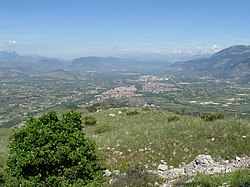Valle Peligna: Difference between revisions
#suggestededit-add 1.0 Tags: Mobile edit Mobile app edit Android app edit |
m Typo fix (via WP:JWB) |
||
| (2 intermediate revisions by 2 users not shown) | |||
| Line 1: | Line 1: | ||
{{Short description| |
{{Short description|Plateau in southern Italy}} |
||
{{Expand Italian|Valle Peligna|date=September 2016}} |
{{Expand Italian|Valle Peligna|date=September 2016}} |
||
{{unreferenced|date=September 2015}} |
{{unreferenced|date=September 2015}} |
||
[[File:Vallepeligna.JPG|thumb|250px|View of Valle Peligna.]] |
[[File:Vallepeligna.JPG|thumb|250px|View of Valle Peligna.]] |
||
The '''Valle Peligna''', also known as ''Conca di Sulmona'', is a plateau in central [[Abruzzo]], southern Italy, included in the [[province of L'Aquila]]. It has a surface of some 100 km |
The '''Valle Peligna''', also known as ''Conca di Sulmona'', is a plateau in central [[Abruzzo]], southern Italy, included in the [[province of L'Aquila]]. It has a surface of some 100 km<sup>2</sup>. |
||
The valley takes its name from the [[Paeligni]]. In prehistoric times, it was occupied by a lake which disappeared after a series of earthquakes approximately 300,000 years ago, leaving the land full of marshes but fertile.{{Citation needed|date=September 2020}} The former barrier between the lake and the sea was in what are now the gorges of [[Popoli]]. Three hills near [[Sulmona]] are the relics of the single island in the lake. |
The valley takes its name from the [[Paeligni]]. In prehistoric times, it was occupied by a lake which disappeared after a series of earthquakes approximately 300,000 years ago, leaving the land full of marshes but fertile.{{Citation needed|date=September 2020}} The former barrier between the lake and the sea was in what are now the gorges of [[Popoli]]. Three hills near [[Sulmona]] are the relics of the single island in the lake. |
||
| Line 9: | Line 9: | ||
The valley is crossed by the rivers [[Aterno]] and [[Sagittario (river)|Sagittario]]. In addition to [[Sulmona]], the main centers in the plateau include [[Raiano]], [[Vittorito]], [[Corfinio]], [[Pratola Peligna]] and [[Pacentro]].{{Citation needed|date=September 2020}} |
The valley is crossed by the rivers [[Aterno]] and [[Sagittario (river)|Sagittario]]. In addition to [[Sulmona]], the main centers in the plateau include [[Raiano]], [[Vittorito]], [[Corfinio]], [[Pratola Peligna]] and [[Pacentro]].{{Citation needed|date=September 2020}} |
||
Historically, it was inhabited by the [[Paeligni]], an [[Oscan]] tribe. |
Historically, it was inhabited by the [[Paeligni]], an [[Oscan]] tribe. |
||
{{coord|42|04|49|N|13|53|16|E|region:IT_source:kolossus-itwiki|display=title}} |
{{coord|42|04|49|N|13|53|16|E|region:IT_source:kolossus-itwiki|display=title}} |
||
Latest revision as of 09:09, 30 March 2024
You can help expand this article with text translated from the corresponding article in Italian. (September 2016) Click [show] for important translation instructions.
|

The Valle Peligna, also known as Conca di Sulmona, is a plateau in central Abruzzo, southern Italy, included in the province of L'Aquila. It has a surface of some 100 km2.
The valley takes its name from the Paeligni. In prehistoric times, it was occupied by a lake which disappeared after a series of earthquakes approximately 300,000 years ago, leaving the land full of marshes but fertile.[citation needed] The former barrier between the lake and the sea was in what are now the gorges of Popoli. Three hills near Sulmona are the relics of the single island in the lake.
The valley is crossed by the rivers Aterno and Sagittario. In addition to Sulmona, the main centers in the plateau include Raiano, Vittorito, Corfinio, Pratola Peligna and Pacentro.[citation needed]
Historically, it was inhabited by the Paeligni, an Oscan tribe.
